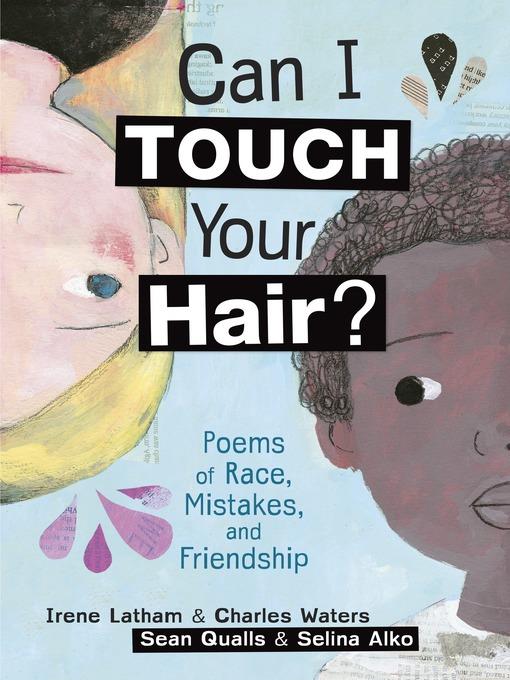
Can I Touch Your Hair?
Poems of Race, Mistakes, and Friendship
فرمت کتاب
ebook
تاریخ انتشار
2018
Reading Level
3
ATOS
4.6
Interest Level
4-8(MG)
نویسنده
Selina Alkoشابک
9781512408881
کتاب های مرتبط
- اطلاعات
- نقد و بررسی
- دیدگاه کاربران
نقد و بررسی

Starred review from November 13, 2017
Two classmates—serving as stand-ins for poets Latham and Waters—reluctantly pair up on a poetry-writing project and reflect on their identities, relationships, and the role race plays in their lives, in more than 30 candid, thought-provoking poems. The students aren’t initially close (“She hardly says anything. Plus, she’s white,” thinks talkative Charles after being assigned to work with Irene), but that soon changes. The children’s passions and preoccupations are revealed in poems that explore topics in parallel—new shoes, dinnertime, parental punishments, and police violence, among them—and the racial divisions of the children’s churches, communities, and school become clear, too. “I smile when Shonda/ comes over, but she doesn’t/ smile back,” writes Irene. “You’ve got/ the whole rest of the playground,/ she says. Can’t we/ at least have this corner?” Qualls and Alko (Why Am I Me?) play into the moody, reflective atmosphere in mixed-media collages whose teardrop/budding leaf motif underscores the way that conversation can lead to growth. The poems delicately demonstrate the complexity of identity and the power of communication to build friendships. Ages 8–12. Authors’ agent: Rosemary Stimola, Stimola Literary Studio. Illustrators’ agent: Rebecca Sherman, Writers House.

January 1, 2018
Gr 4-7-The conceit of a poetry project is this basis for this underdeveloped effort at unpacking racism in a school setting. The poems are presented from two perspectives: Irene's, a white girl, and Charles's, a black boy. ("Mrs. Vandenberg/holds up her hand./Write about anything!/It's not black and white//But it is./Charles is black, /and I'm white.") They take turns responding to everyday occurrences at home, at school, and in public. Charles's poems occasionally introduce important questions ("why do people who/want to look like me hate me so much?"), while Irene's are myopic and fail to challenge bias. In particular, a running thread involving Irene and a classmate, Shonda, is rife with unexamined stereotypes. Shonda is first introduced in "The Playground" as one of the freeze-dancing black girls who won't let Irene join in ("You've got/the whole rest of the playground, /she says. Can't we/at least have this corner?"). Later, when Irene learns that Shonda's family tree is "draped/in chains," she writes her a note apologizing for slavery. Disturbingly, their eventual friendship is compared to The Black Stallion: "I smile/the same way Alec does/when the stallion/nuzzles him/for the very first time." The writing is didactic, with stale imagery (white and black piano keys "singing together"). Qualls and Alko's artwork, done in acrylic paint, colored pencil, and collage, provides literal interpretations of the poems and lacks a certain spark, likely owing to Charles and Irene's almost permanently solemn facial expressions. VERDICT However earnest, this is a clumsy attempt at tackling interpersonal and systemic racism for middle grade readers.-Della Farrell, School Library Journal
Copyright 2018 School Library Journal, LLC Used with permission.

Starred review from October 15, 2017
A fresh approach to exploring interracial communication. In an unusual, long-distance collaboration, poets Latham and Waters have crafted a collection of poems that explore the intersection between race and childhood friendships. Each poet reveals his or her individual perspective on shared experiences by imagining their childhood selves existing in the current day of complex racial realities. Their interactions, expressed through poetic verse, navigate the ambiguous and often challenging feelings that children encounter as they grapple with identity and race--a process forced on them when they are paired for a classroom poetry project. The story takes readers through school days, interludes with concerned parents, and polarizing peer interactions. In one scene, young Irene, who is white, feels ostracized when she isn't invited to play freeze dance with the black girls on the playground. At the beach, young Charles, who is black, is teased by white kids who wear dreadlocks and cornrows, appropriating the culture of black people, while bullying and spewing hate toward Charles. In between the uncomfortable moments are lighter, universal childhood scenarios, as when Charles asserts his choice to be vegan at a traditional soul-food dinner or when Irene describes the solace she finds in her love of horses. Interracial couple Qualls and Alko contribute graceful illustrations that give the feelings expressed visual form. A brave and touching portrayal worthy of sharing in classrooms across America. (Picture book/poetry. 8-12)
COPYRIGHT(2017) Kirkus Reviews, ALL RIGHTS RESERVED.

November 1, 2017
Grades 3-5 When they can't find partners quick enough, Charles and Irene get stuck working together on their poetry project. To Irene, Charles is too opinionated. To Charles, Irene is mousy and dull. They are too different, especially since Irene is white and Charles is black. In mirrored verses, the pair discover their similarities and respectfully examine their differencescovering topics as mundane as buying shoes, and as topical as police brutality, corporal punishment, and white guilt. Latham and Waters see this work as a conversation between their fictional, young poet doppelgangers, meant to heal divides and start conversations. Similarly, the art is a collaboration between a husband-and-wife team, blending collage, colored pencils, and acrylic paint into dreamy abstractions that feature a motif of word flowers blooming across pages where Irene and Charles finally seem to connect. Young readers searching for means to have difficult, emotional, and engaged discussions about race will find an enlightening resource in Irene and Charles' explorations.(Reprinted with permission of Booklist, copyright 2017, American Library Association.)

























دیدگاه کاربران